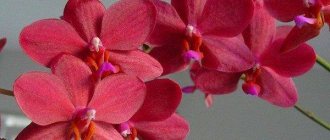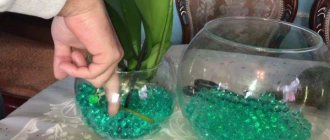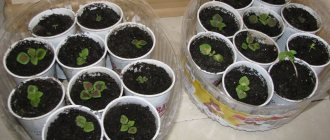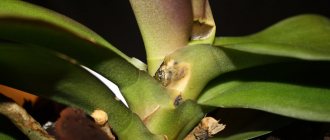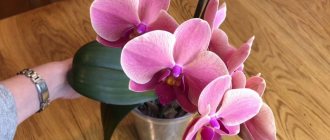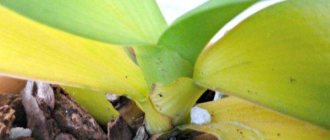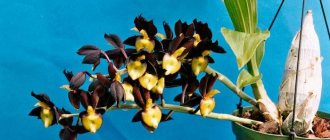Description
The Emperor's Pearl orchid (Phalaenopsis Emperor Jewel), also called Phalaenopsis Jewel, is a monopodial epiphyte .
The height of the stem is up to 40 cm. The leaves are arranged in two rows, dark green, fleshy, length from 15 to 30 cm, width up to 10 cm. The peduncle is long, more than 60 cm. The inflorescence is multi-flowered, branched. The flowers are large, from 6 to 8 cm. The color is dark crimson, the color becomes lighter at the edges and in the middle of the flower.
The flowers are odorless . The plant blooms almost all year round. Most abundant from February to November.
Main types of orchids
Fertilizer for orchids: examples of feeding at home
There are completely different types of orchids in external characteristics, which belong to different families. Each species has several varieties. When choosing a plant, you should carefully study the characteristics of the specimen so as not to buy a harmful indoor flower.
Varieties and types of orchids
Note! The most detailed classification was proposed by R. L. Dressler; he suggested that it would be more convenient to divide orchids into five subfamilies.
Varieties of orchids differ from each other in the shape and size of the flower, the type of flowering, and the appearance of the trunk itself. The choice can be made according to even visual preference.
The most popular flower varieties:
Hysis orchid
The hysis species are plants that have bright green leaves with a sharp tip. Flowering lasts about six months - from April to October. During this period, a peduncle grows, on which there are about seven buds.
The color scheme is as close as possible to yellow and orange. Purple buds are less common. The petals are decorated with spots and stripes of dark color.
Orchid Monza
Growing the Monza variety is a pleasure. The flower is large and can reach a diameter of more than 10 cm; the edges of the petals are slightly darker than the bud itself. The bud itself has a muted coral color. The leaves are dark green, oval shaped, with a dense texture.
What does a Monza orchid look like?
Diamond King
The most popular variety is Diamond King, which is a dark and bright burgundy butterfly. Sometimes it has a bud with a black rim or dark core. The leaves are dense and large emerald green.
Orchid Andorra
The name of this beautiful variety matches the appearance of the bud. Many flowers are formed on the peduncle, which bloom one after another. The shape of the flower is close to the appearance of a large butterfly. The petals are purple or lilac. And along them are specks or stripes of a darker color.
Orchid Jewel
Jewel buds of dark purple or lilac color are located along the peduncle. Flowering continues for more than six months. The castings are dense and have a rich dark green color. Medium sized buds.
Variety Jewel
Varieties of orchids are so common in breeding that it is almost impossible to determine which one became the basis. Different types of buds that resemble butterflies, hummingbirds, and insects can be combined with diverse leaves.
For your information! There are about 150 varieties of selectively bred orchids.
How to grow from seeds?
Growing an orchid from seeds is very difficult. This may take 5-6 years. Seeds are also not so easy to get; they are not available in a regular flower shop. They are most often ordered through online stores. They come from China. You need to purchase containers with screw-on lids that can withstand high temperatures.
Preparation of nutrient medium
Compound:
- 1.5 g fertilizer NPK 20-20-20;
- 20 g sugar;
- 1g crushed activated carbon;
- 5 drops of phytostimulant (such as Epin);
- 1 liter of distilled water;
- 8 g Agar-agar.
- Boil 500 grams of water. Add sugar and agar-agar.
- Cook over low heat until the agar-agar is completely dissolved.
- In another container, heat the remaining water to about 80 degrees. Add fertilizer and coal.
- Combine the two solutions.
- Pour into sterilized jars, 2cm each.
Substrate sterilization
- Take a wide saucepan, put a cloth or towel in it, put jars in it and fill them up to the neck with saline solution (2 tbsp. salt per 1 liter of water). Boil for half an hour.
- Leave for 7 days at room temperature.
If mold does not appear, everything was done correctly.
Sowing
- Take a weak solution of bleach 0.5%, treat all working surfaces, jars, pipette, gloves, seeds.
- Use a pipette to transfer the disinfected seeds into the nutrient medium.
- Place in a warm, not very dark place for 2 months.
- Then the sprouts need to be moved to another substrate. The recipe is the same, only 30g of crushed banana is added to it.
- When transplanting, everything is still treated with a chlorine solution.
- After a couple of months, young plants can be transplanted into orchid substrate, where there is more moss than bark. Fertilize with phytostimulants.
Transfer
- Pot . The size of the pot depends on the roots of the flower. If the plant has outgrown the previous pot, you need to take a new one 1 cm larger. There must be several holes at the bottom of the pot.
- Substrate . Regular soil is not suitable for orchids. You can buy a ready-made substrate; it is sold at any flower shop. You can prepare it yourself: crushed pine bark, heated in the oven, sphagnum moss, peat.
- Landing.
- Carefully remove the plant from the old pot, shake off the roots from the substrate.
- Inspect the roots. Leave green, light yellow and white ones, and cut off dark, dry ones.
- Sprinkle the cut areas with crushed charcoal.
- Place expanded clay or large pieces of bark at the bottom of the pot.
- We fill the plant with substrate to the level of the leaves. We water it.
Care
- Light . The orchid develops well in partial shade. If the leaves turn yellow, there is too much light. If the leaves are too dark and grow poorly, there is not enough light.
- Temperature . The Emperor's Pearl loves a comfortable room temperature of 20-23 degrees.
- Watering . Once a week is enough. If the room is cool, replace watering with spraying. When watering, do not touch the leaves. Wipe the leaves with a damp cloth to remove dust.
- Fertilizers . Orchids need phosphorus, potassium and nitrogen during their growth period. It is better to use ready-made special fertilizers. They have the right ratio of nutrients.
- Transplant . It is done only when the substrate has oxidized, or when the pot has become small. Transplantation is stressful for phalaenopsis.
- Diseases . They appear as spots on the leaves or plaque on the soil. Most often, this is a fungal disease and can occur due to overwatering and poor drainage. The plant should be removed from other flowers, the substrate should be replaced, diseased roots should be cut off, treated with charcoal or activated carbon, and the plant should be sprayed with Fitosporin until the symptoms disappear.
- Bloom . An orchid may not bloom for a long time if it is watered with cold water, or if there is too much water.
Humidity and watering
For precious orchids, air humidity is very important. This is the most difficult moment in growing them. Because of this parameter, this variety of orchids is classified as a plant that is recommended to be grown in flower displays or indoor greenhouses.
However, variegated orchids feel great in ordinary indoor conditions, and not even necessarily in a florarium. Achieving optimal air humidity is quite simple using a humidifier. The least capricious in this sense is Ludisia, which can be content with average indicators. Other species require at least 70% humidity.
Precious orchids require fairly intensive watering. Complete drought and drying out of the soil even in its middle part should not be allowed. Precious orchids actively develop only with stable, medium-high soil moisture. You can water the plants either in the classical way or by immersing them in water so that the substrate is saturated with moisture. In cold weather, watering should be adjusted depending on the drying of the soil. Only for Anectochilus in winter the humidity should be halved.
For variegated orchids, the quality of water for irrigation is of great importance. It is allowed to use only rain, melted, boiled or distilled water.
Reproduction
- The emperor's pearl reproduces after flowering. A baby appears. When a baby develops aerial roots, it can be transplanted from an adult plant.
- An adult plant that has more than 6 leaves and many aerial roots can be divided with pruning shears. Treat the cut with charcoal and transplant the two parts into different pots.
Growing and caring for the Emperor's Pearl orchid is quite a complicated matter . But this work is justified, since it will delight you with its flowering all year round.
Pests of Ludisia
Ludisia is rarely affected by pests. Most often these are typical pests of indoor plants - scale insects, spider mites, mealybugs, aphids, which cause damage to leaves.
In this case, visible insects are removed, the leaves and stem are wiped with a cotton swab dipped in diluted alcohol or garlic infusion, and the plant is treated with anti-pest preparations until they are completely destroyed.
For preventive purposes, nearby plants are inspected.
Ludisia in the store
Ludisia is represented by several varieties, differing in the color of the leaves and the pattern of veins.
Below are the most popular varieties.
Ludisia Dawsoniana
Ludisia Discolor
Ludisia Discolor Silver Velvet
Ludisia Discolor Black Velvet
Ludisia Discolor Green Velvet
Ludisia Discolor 'Super Veination'
Ludisia Alba
Ludisia Odina
Ludisia Rubrovenia
Ludisia Tanlaniana
Ludisia
Share link:
Rate the article!
[Total: 0 Average: 0]
